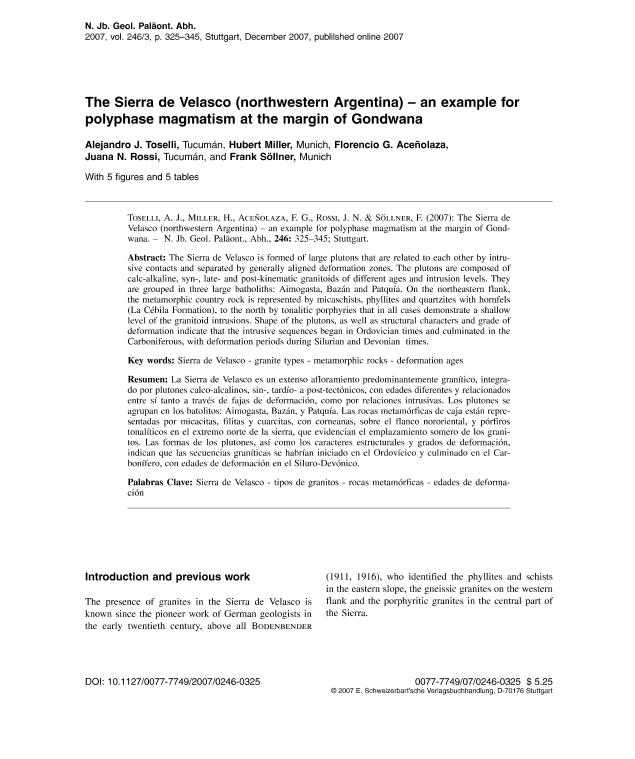Mostrar el registro sencillo del ítem
dc.contributor.author
Toselli, Alejandro Jose

dc.contributor.author
Miller, Hubert
dc.contributor.author
Aceñolaza, Florencio Gilberto

dc.contributor.author
Rossi, Juana Norma

dc.contributor.author
Söllner, Frank
dc.date.available
2020-03-13T19:50:05Z
dc.date.issued
2007-12
dc.identifier.citation
Toselli, Alejandro Jose; Miller, Hubert; Aceñolaza, Florencio Gilberto; Rossi, Juana Norma; Söllner, Frank; The Sierra de Velasco of Northwest Argentina. An example for polyphase magmatism at the margin of Gondwana; E Schweizerbartsche Verlags; Neues Jahrbuch für Geologie und Palaontologie - Abhandlungen; 246; 3; 12-2007; 325-345
dc.identifier.issn
0077-7749
dc.identifier.uri
http://hdl.handle.net/11336/99574
dc.description.abstract
The Sierra de Velasco is formed of large plutons that are related to each other by intrusive contacts and separated by generally aligned deformation zones. The plutons are composed of calc-alkaline, syn-, late- and post-kinematic granitoids of different ages and intrusion levels. They are grouped in three large batholiths: Aimogasta, Bazán and Patquía. On the northeastern flank, the metamorphic country rock is represented by micaschists, phyllites and quartzites with hornfels (La Cébila Formation), to the north by tonalitic porphyries that in all cases demonstrate a shallow level of the granitoid intrusions. Shape of the plutons, as well as structural characters and grade of deformation indicate that the intrusive sequences began in Ordovician times and culminated in the Carboniferous, with deformation periods during Silurian and Devonian times. © 2007 E. Schweizerbart'sche Verlagsbuchhandlug.
dc.description.abstract
La Sierra de Velasco es un extenso afloramiento predominantemente granítico, integrado por plutones calco-alcalinos, sin-, tardío- a post-tectónicos, con edades diferentes y relacionados entre sí tanto a través de fajas de deformación, como por relaciones intrusivas. Los plutones se agrupan en los batolitos: Aimogasta, Bazán, y Patquía. Las rocas metamórficas de caja están representadas por micacitas, filitas y cuarcitas, con corneanas, sobre el flanco nororiental, y pórfiros tonalíticos en el extremo norte de la sierra, que evidencian el emplazamiento somero de los granitos. Las formas de los plutones, así como los caracteres estructurales y grados de deformación, indican que las secuencias graníticas se habrían iniciado en el Ordovícico y culminado en el Carbonífero, con edades de deformación en el Siluro-Devónico.
dc.format
application/pdf
dc.language.iso
eng
dc.publisher
E Schweizerbartsche Verlags

dc.rights
info:eu-repo/semantics/openAccess
dc.rights.uri
https://creativecommons.org/licenses/by-nc-sa/2.5/ar/
dc.subject
DEFORMATION AGES
dc.subject
GRANITE TYPES
dc.subject
METAMORPHIC ROCKS
dc.subject
SIERRA DE VELASCO
dc.subject.classification
Geología

dc.subject.classification
Ciencias de la Tierra y relacionadas con el Medio Ambiente

dc.subject.classification
CIENCIAS NATURALES Y EXACTAS

dc.title
The Sierra de Velasco of Northwest Argentina. An example for polyphase magmatism at the margin of Gondwana
dc.title
La sierra de Velasco en el noroeste argentino. Un ejemplo de magmatismo polifase en el margen de Gondwana.
dc.type
info:eu-repo/semantics/article
dc.type
info:ar-repo/semantics/artículo
dc.type
info:eu-repo/semantics/publishedVersion
dc.date.updated
2020-03-11T18:33:59Z
dc.journal.volume
246
dc.journal.number
3
dc.journal.pagination
325-345
dc.journal.pais
Alemania

dc.journal.ciudad
Stuttgart
dc.description.fil
Fil: Toselli, Alejandro Jose. Consejo Nacional de Investigaciones Científicas y Técnicas. Centro Científico Tecnológico Conicet - Tucumán. Instituto Superior de Correlación Geológica. Universidad Nacional de Tucumán. Facultad de Ciencias Naturales e Instituto Miguel Lillo. Departamento de Geología. Cátedra Geología Estructural. Instituto Superior de Correlación Geológica; Argentina
dc.description.fil
Fil: Miller, Hubert. Universidad de Munich; Alemania
dc.description.fil
Fil: Aceñolaza, Florencio Gilberto. Consejo Nacional de Investigaciones Científicas y Técnicas. Centro Científico Tecnológico Conicet - Tucumán. Instituto Superior de Correlación Geológica. Universidad Nacional de Tucumán. Facultad de Ciencias Naturales e Instituto Miguel Lillo. Departamento de Geología. Cátedra Geología Estructural. Instituto Superior de Correlación Geológica; Argentina
dc.description.fil
Fil: Rossi, Juana Norma. Universidad Nacional de Tucumán; Argentina
dc.description.fil
Fil: Söllner, Frank. Universidad de Munich; Alemania
dc.journal.title
Neues Jahrbuch für Geologie und Palaontologie - Abhandlungen

dc.relation.alternativeid
info:eu-repo/semantics/altIdentifier/doi/https://dx.doi.org/10.1127/0077-7749/2007/0246-0325
dc.relation.alternativeid
info:eu-repo/semantics/altIdentifier/url/https://www.ingentaconnect.com/content/schweiz/njbgeol/2007/00000246/00000003/art00006;jsessionid=xihjcssxs0rj.x-ic-live-02
Archivos asociados
